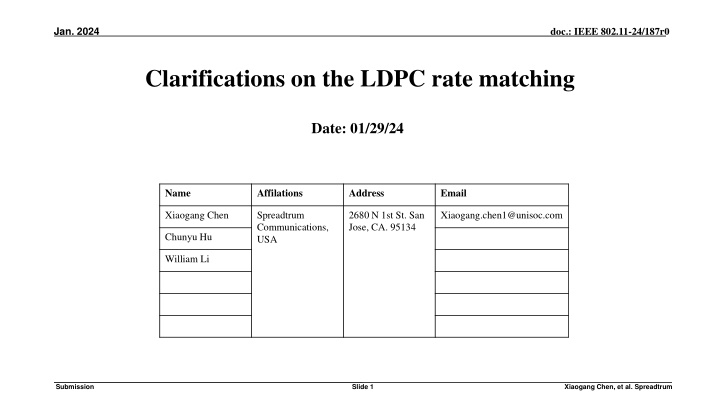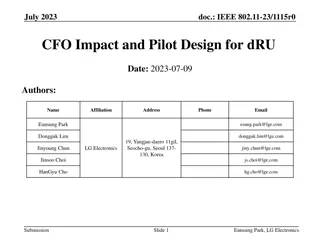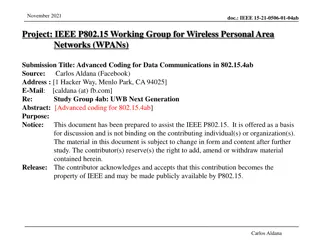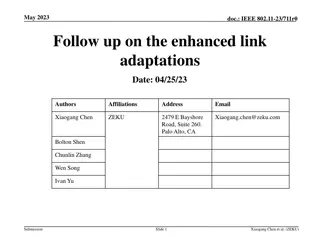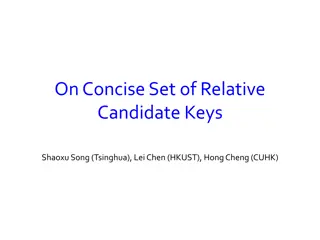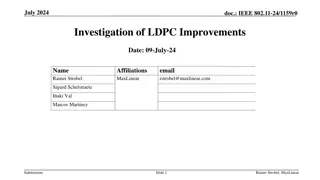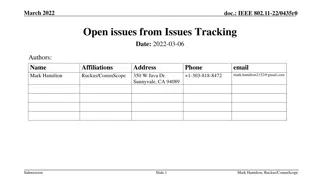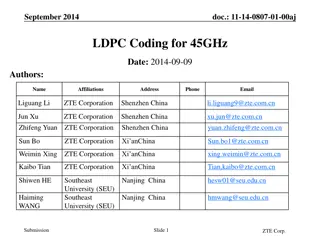IEEE 802.11-24/187r0 Clarifications on LDPC Rate Matching
The document discusses PSDU size statistics for various scenarios like online meetings, remote desktop work, WFH, file downloads, and streaming. It emphasizes the need for detailed elaboration on PSDU size statistics and highlights additional post-processing and measurements conducted. The measurements setup includes data from a single-family house with mesh APs and six compatible devices. Different usage scenarios such as remote desktop, WFH tasks, and streaming auto rate are also analyzed and compared against existing statistics.
Download Presentation

Please find below an Image/Link to download the presentation.
The content on the website is provided AS IS for your information and personal use only. It may not be sold, licensed, or shared on other websites without obtaining consent from the author.If you encounter any issues during the download, it is possible that the publisher has removed the file from their server.
You are allowed to download the files provided on this website for personal or commercial use, subject to the condition that they are used lawfully. All files are the property of their respective owners.
The content on the website is provided AS IS for your information and personal use only. It may not be sold, licensed, or shared on other websites without obtaining consent from the author.
E N D
Presentation Transcript
Jan. 2024 doc.: IEEE 802.11-24/187r0 Clarifications on the LDPC rate matching Date: 01/29/24 Name Affilations Address Email Xiaogang Chen Spreadtrum Communications, USA 2680 N 1st St. San Jose, CA. 95134 Xiaogang.chen1@unisoc.com Chunyu Hu William Li Submission Slide 1 Xiaogang Chen, et al. Spreadtrum
Jan. 2024 doc.: IEEE 802.11-24/187r0 Outline Background PSDU size statistics for different scenarios Online meeting; Remote desktop; Daily WFH; File download; Streaming. Summary and clarifications Submission Slide 2 Xiaogang Chen, et al. Spreadtrum
Jan. 2024 doc.: IEEE 802.11-24/187r0 Background The statistics of PSDU size in [1] (copied to the right) are leading different interpretations based on offline discussions; The one page slide of statistics on the PSDU size in [1] needs to be well elaborated; More post processing and measurements have been done in this deck. Submission Slide 3 Xiaogang Chen, et al. Spreadtrum
Jan. 2024 doc.: IEEE 802.11-24/187r0 Measurements setup Single family house with two 11ax mesh AP. Considered as good coverage. Six 11ax compatible device in the house. Measurements duration: Online meeting: ~ 1 hour; Remote desktop: ~ 4 hours; Daily WFH: ~ 4 hours; File download: 10GB; UHD/SD Video streaming: ~ 0.5 hour each. Post processing: ONLY LDPC coded Qos data is counted; Measurement is done per App and per non-AP STA. Convert MPDU to A-MPDU size if aggregation presents; CDF to show the distribution of packet size in general; CCDF to zoom in the percentile of large packet size. Note: The measurement conducted represents a typical home scenario, but different traffic pattern may be observed for different setups. e.g. dense apartment, enterprise, level of MSDU aggregation etc. Submission Slide 4 Xiaogang Chen, et al. Spreadtrum
Jan. 2024 doc.: IEEE 802.11-24/187r0 Scenario 1: Remote desktop & online meeting These two apps are the most frequently used by myself. Very similar as the statistics in [1] for webex. Submission Slide 5 Xiaogang Chen, et al. Spreadtrum
Jan. 2024 doc.: IEEE 802.11-24/187r0 Scenario 2: WFH - RemoteDesktop, email, chat, search etc. Sniffed from morning to noon when conducting daily work. Match the statistics of the 1sttable in [1]. Submission Slide 6 Xiaogang Chen, et al. Spreadtrum
Jan. 2024 doc.: IEEE 802.11-24/187r0 Scenario 3: Streaming auto rate Auto rate means the default rate auto selected by the streaming app (Mostly 720P). ~10% large (relatively) packet was observed. Most packets are still sub-1KB. Submission Slide 7 Xiaogang Chen, et al. Spreadtrum
Jan. 2024 doc.: IEEE 802.11-24/187r0 Scenario 4: UHD Streaming UHD (2160P) movie streaming is traffic demanding. Stair shape is not because of small number of samples but due to only a few A-MSDU size. The table of streaming in [1] didn t show the details because of no post-processing had been done. Slide 8 Submission Xiaogang Chen, et al. Spreadtrum
Jan. 2024 doc.: IEEE 802.11-24/187r0 Scenario 5: File Download Similar trend with UHD streaming with larger aggregation observed. Packet size is larger: ~25% A-MPDU observed. Packet size vary in the range of 3KB ~ 200KB ~30% A-MSDU observed (3164B) ~28% MSDU observed (16xxB) Submission Slide 9 Xiaogang Chen, et al. Spreadtrum
Jan. 2024 doc.: IEEE 802.11-24/187r0 Summary and clarifications For non-traffic demanding apps, observations are similar as the statistics shown in [1]. A-MPDU post processing improves the accuracy of statistic on the 10% tail (for small packet size dominated apps). Refer to the backup. For traffic demanding apps, post processing shows more details that are not included in [1]. The PSDU size is quite related to the traffic pattern of individual applications: Throughput demanding application is dominated by large packets. The PSDU size could be quite large (hundreds of KB observed). MB packets was observed in [1]. Several daily working related apps is dominated by small packets. The optimization of features in 11bn should consider different traffic patterns. Submission Slide 10 Xiaogang Chen, et al. Spreadtrum
Jan. 2024 doc.: IEEE 802.11-24/187r0 Reference [1] 11-23-0667-01-0uhr-revisiting-of-the-rate-matching-for-ldpc Submission Slide 11 Xiaogang Chen, et al. Spreadtrum
Jan. 2024 doc.: IEEE 802.11-24/187r0 Backup Converting MPDU to A-MPDU change the distribution only for the 5%-10% tail. Submission Slide 12 Xiaogang Chen, et al. Spreadtrum
